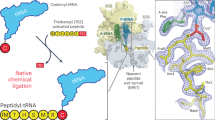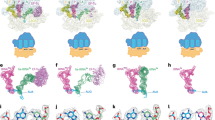Abstract
IT has been proposed that a key event in the recognition of a prokaryotic protein initiation site by the ribosome is the interaction between the 3′-terminal sequence of the 16S rRNA and a purine-rich sequence preceding the initiator triplet by three to nine nucleotides1,2 This hypothesis predicts that if the 3′-terminal region of the 16S rRNA were blocked, binding of the ribosome to the initiator region of an mRNA should be diminished or prevented, while binding to the trinucleotide A-U-G should not be affected We have shown that the oligonucleotide A-G-A-G-G-A-G-G-UOH (P-2a), eight bases of which are complementary to the sequence A-C-C-U-C-C-U-U-AOH at the 3′-termmal region of 16S rRNA (ΔG = −16.9 kcal mol−1 calculated as described in Table 1), binds tightly to the 30S ribosome and is released as a complex with the 3′-terminal 49-mer of 16S rRNA after digestion with cloacin DF13 (ref. 3). We report here that this oligonucleotide either strongly inhibits Qβ RNA binding to 70S ribosomes or decreases the stability of the initiation complex formed in its presence As we found that the formation of complexes of pA-U-G and 70S ribosomes was, not inhibited by the oligonucleotide, we conclude that inhibition (or destabilisation) of Qβ RNA binding is not due to an effect on the interaction between fMet-tRNA and the initiation triplet or on the association of the 30S and 50S ribosome subunits.
Similar content being viewed by others
References
Shine, J. & Dalgarno, L. Nature 254, 34–38 (1975).
Steitz, J. A. in Biological Regulation and Control (ed. Goldberger, R.) (Plenum, in the press).
Taniguchi, T. & Weissmann, C. J. molec. Biol. (submitted).
Hindley, J. & Staples, D. H. Nature 224, 964–967 (1969).
Taniguchi, T. & Weissmann, C. J. molec. Biol. 118, 533–565 (1978).
Steitz, J. A. Nature new Biol. 236, 71–75 (1972).
Lodish, H. F. & Robertson, H. D. Cold Spring Harb. Symp. quant. Biol. 34, 655–673 (1969).
Revel, M. & Greenshpan, H. Eur. J. Biochem. 16, 117–122 (1970).
Dunn, J. J., Buzash-Pollert, E. & Studier, F. W. Proc. natn. Acad. Sci. U.S.A. 75, 2741–2745 (1978).
Steitz, J. A. Proc. natn. Acad. Sci. U.S.A. 70, 2605–2609 (1973).
Walz, A., Pirrotta, V. & Ineichen, K. Nature 262, 665–669 (1976).
Ptashne, M. et al. Science 194, 156–161 (1976).
Weissmann, C., Colthart, L. & Libonati, M. Biochemistry 7, 865–874 (1968).
Kolakofsky, D., Billeter, M. A., Weber, H. & Weissmann, C. J. molec. Biol. 76, 271–284 (1973).
Givol, D., Weinstein, Y., Gorecki, M. & Wilchek, M. Biochem. biophys. Res. Commun. 38, 825–830 (1970).
Sanger, F. & Brownlee, G. G. Meth. Enzym. 12A, 361–381 (1976).
Gralla, J. & Crothers, D. M. J. molec. Biol. 73, 497–511 (1973).
Author information
Authors and Affiliations
Rights and permissions
About this article
Cite this article
TANIGUCHI, T., WEISSMANN, C. Inhibition of Qβ RNA 70S ribosome initiation complex formation by an oligonucleotide complementary to the 3′ terminal region of E. coli 16S ribosomal RNA. Nature 275, 770–772 (1978). https://doi.org/10.1038/275770a0
Received:
Accepted:
Issue Date:
DOI: https://doi.org/10.1038/275770a0
- Springer Nature Limited
This article is cited by
-
What history tells us XIV. Regulation of gene expression by non-coding RNAs: the early steps
Journal of Biosciences (2008)
-
Localization of the 3′ End of 16S rRNA in Escherichia coli 30S ribosomal subunits by Immuno electron microscopy
Molecular and General Genetics MGG (1981)
-
Proximity of mRNA5′-region and 18S rRNA in eukaryotic initiation complexes
Nature (1980)





